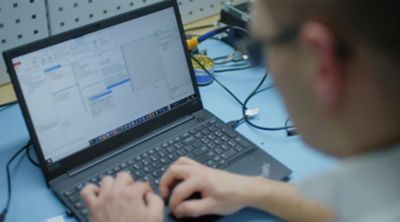-
United States -
United Kingdom -
India -
France -
Deutschland -
Italia -
日本 -
대한민국 -
中国 -
台灣
-
Ansysは、シミュレーションエンジニアリングソフトウェアを学生に無償で提供することで、未来を拓く学生たちの助けとなることを目指しています。
-
Ansysは、シミュレーションエンジニアリングソフトウェアを学生に無償で提供することで、未来を拓く学生たちの助けとなることを目指しています。
-
Ansysは、シミュレーションエンジニアリングソフトウェアを学生に無償で提供することで、未来を拓く学生たちの助けとなることを目指しています。
ANSYS BLOG
August 4, 2021
Advancing Functional Safety Amid Automotive Industry Disruptions
The automotive industry has responded to disruptions in the mobility ecosystem with advancements in connected cars, autonomous vehicles and electrification technologies. What does that mean for engineers charged with implementing functional safety analysis in the fast-paced development process? Functional Safety Engineer Tomasz Lokietek, an automotive consultant at Spyrosoft, shares his insights with us.
Could you introduce yourself and your company?
Tomasz Lokietek: I am a functional safety engineer/manager who supports the development of safety-critical products, together with our customers. We support process development in the software domain, which includes safety requirements and safety process requirements. We are involved in system and software development, and support analysis for customers’ development decision – advising on whether they align with standard best practices or optimizing their solutions. Spyrosoft touches all aspects of the development lifecycle: concept, architecture, software, and systems development to manufacturing.
How will advancements in connected cars, autonomous vehicles and electrification technologies impact the global automotive industry overall?
TL: New standards are slowly emerging to design proper e-vehicles. We are at the point in the trends that leaders will be going to market soon. Still, there are new players on the market who don’t completely understand the safety requirements and need to learn about the standards and best practices. If we go to such a customer, Spyrosoft comes in to provide systemic support to find the best solution for them, so they will be successful by implementing what we propose.
What new trends, projects or technology do you see in the industry that requires functional safety expertise?
TL: AD (autonomous drive) and ADAS (advanced driver-assistance systems) support or remove responsibility from human drivers. This is the biggest challenge right now. The safety concepts are relying on the final decision maker, which is now a human, and changing that paradigm to a machine is new. Different OEMs have different design proposals for that, but there isn’t a clear gold standard yet. ADAS/autonomous driving solutions are still in development. There are different approaches to minimize areas where humans can give the role to the machine (for example, on the highway only, or in a parking lot), but no one knows what is ahead or the next steps with regulations.
“You need to prove you have a safe vehicle. It provides a competitive advantage! Safety and security are differentiators.”
Why is functional safety critical to the success of the industry and what challenges might they face when implementing functional safety into their development process?
TL: Without safety, you are not going to sell the vehicle. By changing the paradigm from human to machine, we are entering a new area where responsibility for accidents is not clear anymore. You can develop regulatory systems to decide responsibility, but if it’s an autonomous driver, who is responsible – the driver or the OEM?
If the safety concept is well established, the chances of accidents will be minimized, and drivers will be more willing to drive these vehicles. You need to prove you have a safe vehicle. It provides a competitive advantage! Safety and security are differentiators.
We provide a comprehensive solution to help customers navigate the safety and security challenges faced by the automotive industry. If you are providing a hardware product, how will you determine the safety of the product? The design must be analyzed, and safety proven, giving our customers a competitive advantage: Be first, provide the best.
Spyrosoft supports process development in the software domain, which includes safety requirements and safety process requirements.
If one of the biggest challenges in the industry is increasing complexity. How does Ansys medini analyze help manage this complexity?
TL: The more top-level requirements in the project, the more complex your product is and the more you need a proper tool to attack your safety case from all angles. Without a systematic approach to analysis, you are not able to convince people your product is safe. Having a tool like Ansys medini analyze, where standards are applied, helps you be more systematic in your approach. Ansys medini analyze is becoming more popular in the industry because it enables a systematic approach to the safety lifecycle. You can create a record of the logic and development of the safety in the design, which helps you prove your case to OEMs, users, and regulatory bodies.
“Ansys medini analyze wins at overcoming this challenge by implementing a safety lifecycle that reflects the ISO 26262 standard and does so in a very modular way to help with reuse.”
If you want to add more safety layers, it is going to increase the overall cost of development. How do you help your customers reduce the cost of ensuring safety?
TL: The complexity of in-vehicle systems is nearly doubling with each generation of vehicle. We have to face the increased cost due to that complexity. There are efficient methods developed to deal with this, such as standardization and reuse of ideas and concepts. Ansys medini analyze wins at overcoming this challenge by implementing a safety lifecycle that reflects the ISO 26262 standard and does so in a very modular way to help with reuse. So, you can develop an item or concept at the software and hardware levels and apply to various projects, and easily identify points where there is overlap or new analysis is needed. This accelerates the development for new features and is not present in other tools on the market today.
Automation and reuse accelerate your work with better accuracy. You can save up to 50% of your time and analysis efforts.
Can you please walk us through an example project that demonstrates the importance of functional safety analysis?
TL: Sure. One customer wanted to perform fault tree analysis (FTA) & failure modes, effects and diagnostic analysis (FMEDA) on a power inverter for safety analysis of the hardware.
For the FTA, both qualitative and quantitative analysis are required to know what must happen to violate the safety goal and assess what can help on system level. Also, the software and hardware team has to answer what can happen in the software and hardware that will cause a basic event and violate the safety goal. Ansys medini analyze helps teams work on different levels and automate tasks by writing scripts in within the tool, which reduces repetitive tasks and provides a consistency check to remove manual reviews.
For FMEDA, you can copy and reuse analysis from other projects. You can use results to connect to the hardware tree with reliability figures in FMEDA and identify the reliability of the safety goal. This removes manual analysis in multiple tools, which decreases the risk of making a mistake.
Automation and reuse accelerate your work with better accuracy. You can save up to 50% of your time and analysis efforts.
You do need to spend some time on defining project and creating scripts on how to reuse the data, but once this is done your analysis is faster with higher quality. The first time this company performed the safety analysis, it took three people a few months to complete; however, once safety cases were developed, the time and resources needed on later projects were cut in half!













